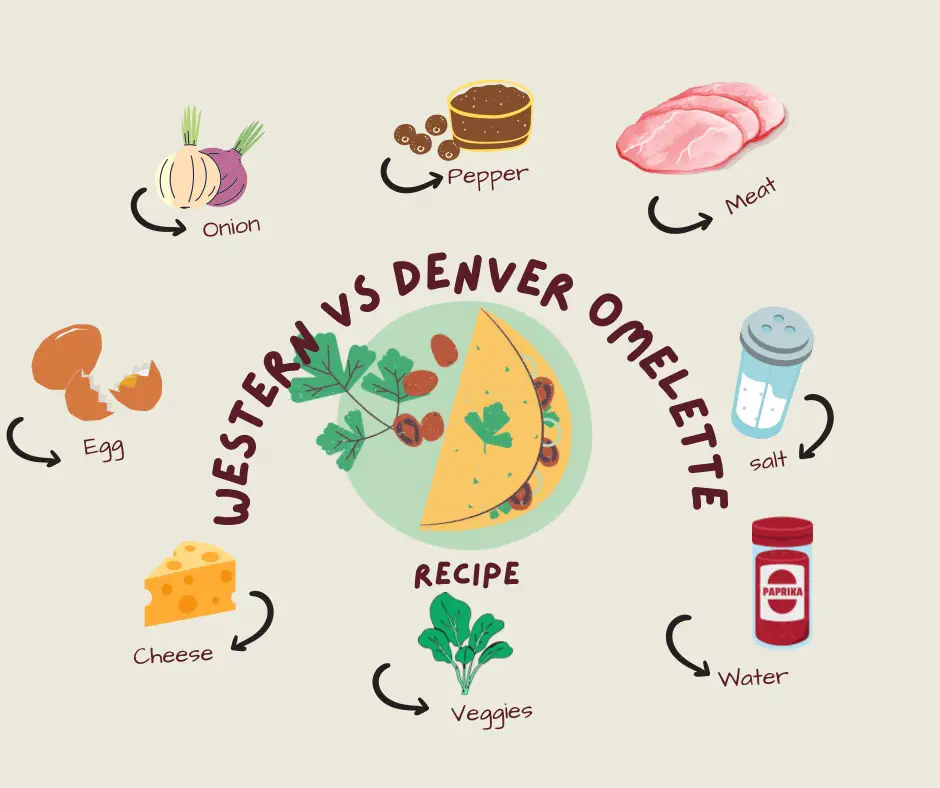The Denver omelet and the Western omelet are perhaps two of the most recognized names when it comes to breakfast in America.
Born from the same trifecta of hearty ham, crispy onions and green bell peppers, one can’t help but wonder – is there more than a name that separates these two dishes?
In this article, we will find out the difference between Denver and Western omelets, and also explore their history and unique method of preparation.

What Defines A Western Omelette?
Unlike French omelette, Western omelette is loaded with rich and vibrant ingredients.
Nestled within folds of fluffy scrambled eggs you’ll find diced ham, chunky bell peppers and oozy cheese.
This combination of ham’s robust salinity, peppers’ freshness and cheese’s richness make the Western omelette a beloved start to many people’s day.
Looking to whip up your own?
Here’s how to do so:
Start off by whisking your eggs until they’re frothy and evenly mixed.
Season them well – remember that good seasoning is the backbone of any dish, then put this bowl aside for now.
Next step involves some skillet action: Melt butter until it lightly browns, then add in your diced onions, bell peppers and meat.
Sprinkle in some smoked paprika too, if you fancy a hint of deep smoky flavor. Let everything cook until softened and slightly browned.
After transferring your cooked ingredients onto a plate for temporary safekeeping, clean out your skillet before returning it back to heat.
Pour in more butter before adding your prepped eggs into the mix. Cook them until just set but still tender – overcooked eggs lose their luxurious texture!
Once ready, scatter cheese on one half of your now beautifully cooked omelette followed by an even sprinkle of your sautéed ham and veggies.
After folding over the other half to create that classic semi-circular shape we all love our omelettes in, slide it onto a plate.
Is Denver Omelette The Same As Western Omelette?
The truth is, Denver omelettes and Western omelettes are essentially the same thing!
Surprised?
Well, brace yourselves – their ingredients are virtually identical.
It’s the same diced ham, onions, bell peppers, and cheese folded into a fluffy egg blanket, what defines both types of omelettes.
So why the difference in nomenclature?
It’s all about geography and what people call it in different regions.
In some areas it’s known as the “Western,” while in others it’s known as the “Denver.”
What Is The History Of Denver Omelette? And Why Is It Called Denver Omelette?
The Story You Haven’t Heard about The Denver Omelette
Two theories attempt to explain the origins of Denver Omelette, and here are their engaging narratives:
Theory 1: Once known as a ‘Denver Sandwich,’ this classic omelette was not originally served on a plate but smartly tucked between slices of bread. Gaining its peak popularity in the 1950s, this sandwich either sprang out from cattle drivers’ innovation or Chinese railroad cooks’ capacity to adapt who turned it into a portable version of egg foo yong. At some point, the bred go left out and the classic omelette began its journey!
Theory 2: Taking cues from Spanish culinary traditions, some claim that the Denver omelette mirrors certain aspects of the revered Spanish omelette. An 1817 account laments on how poverty-stricken Spaniards resorted to making tortilla-like breakfast using eggs mixed with potatoes and other fillers—sounds familiar?
As for why it’s called Denver, many claim that the dish was initially recognized as a “Southwestern” or “Western omelette”, but was later renamed after its place of adoption—Denver, Colorado.
What’s The Difference Between Omelet and Omelette?
Apart from stirring a whole lot of confusion, ‘omelet’ and ‘omelette’ essentially refer to an identical dish. Yes!
They describe a delicacy crafted from beaten eggs cooked until set and comfortably folded over, often housing a delicious filling.
The confusion lies not in the preparation or presentation but in the spelling.
‘Omelet’, as it turns out, is the usual American spelling while “omelette” is the preferred spelling in British English.
However, despite this transatlantic divide over spelling preferences, both are pronounced in the exact same manner (ahm-let).
Tracing back to its origins, ‘omelette’ in general boasts of French roots and first found its way to print around the late 17th century.
The American soon embraced it, albeit with a slight tweak – they dropped the last -te off. The motivation behind such abbreviation still remains shrouded in mystery.

